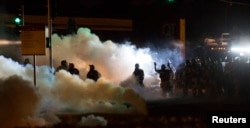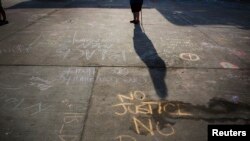With little public awareness and scant oversight, the U.S. government has equipped state and local police agencies with surplus military equipment worth billions of dollars and conducted tactical military training programs with law enforcement for the past two decades.
These efforts initially were designed to counter increased crime in American cities in the 1990s as part of the "war on drugs." They have been significantly ramped up since the September 11, 2001, terror attacks, critics say.
The police department in Ferguson, Mo., which confronted protesters angered by Saturday’s shooting death of unarmed 18-year-old Michael Brown by a local officer, is one of 8,000 law enforcement agencies receiving lethal equipment through a U.S. Defense Department initiative.
The congressionally-mandated 1033 Program has been run by the Pentagon’s Defense Logistics Agency Law Enforcement Support Office (LESO) since 1995.
St. Louis County police have received 12 5.56-mm rifles, six .45 caliber pistols, multiple cargo trailers and other vehicles, as well as night vision equipment through the program, a Missouri public safety official said Thursday. Ferguson is in St. Louis County.
Since its inception 19 years ago, the 1033 Program has provided $5.1 billion worth of equipment to more than 17,000 law enforcement agencies. Of that, five percent were weapons transfers, according to data shared with VOA by LESO and 0.35 percent were tactical vehicles.
The transferred military equipment includes small arms, such as pistols and automatic rifles, along with heavy armored vehicles known as MRAPs, used by American forces in the Iraq and Afghanistan wars.
“The federal government requires agencies that receive 1033 equipment to use it within one year of receipt, so there can be no doubt that participation in this program creates an incentive for law enforcement agencies to use military equipment,” the American Civil Liberties Union wrote in a June report.
Since the September 11 attacks, two Department of Homeland Security grant programs have expanded money available for police militarization to combat terrorism.
Officials acknowledge, though, that terror attacks are rare on U.S. soil, and equipment bought with DHS funds is used mostly for civil unrest.
Justice Department programs also can be used to fund law enforcement activities, and grantees have used awards to purchase items such as rubber bullets, tear gas and body armor, according to the ACLU report.
Reaction Mounts
In the past five days, senior U.S. officials have condemned how this equipment is being used on the streets of Ferguson, Missouri.
"At a time when we must seek to rebuild trust between law enforcement and the local community, I am deeply concerned that the deployment of military equipment and vehicles sends a conflicting message," U.S. Attorney General Eric Holder said Thursday.
Four nights of confrontation between demonstrators and law enforcement personnel under the loose coordination of St. Louis County police made Ferguson appear like a war zone.
Images of exploding tear gas, armored vehicles cruising the streets and police in full riot gear pointing military-style assault weapons at unarmed protesters flashed across television screens, shocking audiences worldwide.
Internet activists from the Middle East even tweeted practical advice to Ferguson protesters about how to deal with tear gas. “Solidarity with #Ferguson. Remember to not touch your face when teargased or put water on it. Instead use milk or coke!” read one.
“I saw what everybody else saw. And I didn’t like it,” Missouri Gov. Jay Nixon told CNN Friday, a day after criticizing the heavy-handed police reaction and putting the Missouri State Highway Patrol in charge of security.
“We need to de-militarize this situation - this kind of response by the police has become the problem instead of the solution,” U.S. Senator Claire McCaskill of Missouri said. “I obviously respect law enforcement’s work to provide public safety, but my constituents are allowed to have peaceful protests, and the police need to respect that right and protect that right,” she said.
Ferguson police Chief Thomas Jackson defended the use of force against protesters, nine of whom have been charged with looting and vandalizing stores on Sunday night.
“If firebombs are being thrown, property gets destroyed, shots get fired … we have to respond to deadly force,” he said.
Law enforcement officials, however, are by no means of one mind on the issue.
St. Louis Police chief Sam Dotson told The Associated Press he was so concerned about the way Ferguson officers handled the unrest that he pulled his employees out, saying the actions taken in Ferguson were not "tactics I would use in the city of St. Louis."














